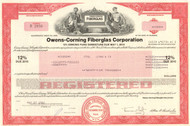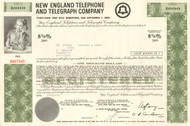Categories
Categories
- Home
- Communication and Utilities
- Communications
- General Telephone & Electronics Corporation 1970's (GTE)
General Telephone & Electronics Corporation 1970's (GTE)
Product Description
General Telephone & Electronics Corporation bond certificate 1970's
Nice telecom piece with a vignette of Mercury in front of city scenes. Nice under print of company logo. Issued and cancelled. Printed date of 189_.
GTE Corporation, formerly General Telephone & Electric Corporation (1955-1982) was the largest independent telephone company in the United States during the days of the Bell System.
Originally founded in 1926 as Associated Telephone Utilities, it went bankrupt in 1933 during the Great Depression, and reorganized as General Telephone in 1934. In 1991, it acquired the third largest independent, Continental Telephone (ConTel). They also owned Automatic Electric, a telephone equipment supplier similar in many ways to Western Electric, and Sylvania Lighting, the only non-communications-oriented company under GTE ownership. GTE provided local telephone service to a large number of areas of the U.S. through operating companies, much as American Telephone & Telegraph provided local telephone service through its 22 Bell Operating Companies.
The company also acquired BBN Planet, one of the earliest Internet service providers, in 1997. That division became known as GTE Internetworking, and was later spun off into the independent company Genuity to satisfy Federal Communications Commission (FCC) requirements regarding the GTE-Bell Atlantic merger that created Verizon. In the Caribbean, CONTEL purchased several major stakes in the newly independent countries of the British West Indies (namely in Barbados, Jamaica, and Trinidad and Tobago). Prior to GTE's merger with Bell Atlantic, GTE also maintained an interactive television service joint-venture called GTE main Street as well as an interactive entertainment and video game publishing operation, GTE Interactive Media.
GTE's heritage can be traced to 1918, when three Wisconsin public utility accountants (John F. O'Connell, Sigurd L. Odegard, and John A. Pratt) pooled $33,500 to purchase the Richland Center Telephone Company, serving 1,466 telephones in the dairy belt of southern Wisconsin. In 1920, the three accountants formed a corporation, Commonwealth Telephone Company, with Odegard as president, Pratt as vice-president, and O'Connell as secretary. Richland Center Telephone became part of Commonwealth Telephone, which quickly purchased telephone companies in three nearby communities. In 1922, Pratt resigned as vice-president and was replaced by Clarence R. Brown, a former Bell System employee.
By the mid-1920s, Commonwealth Telephone had extended beyond Wisconsin borders and purchased the Belvidere Telephone Company in Illinois. It also diversified into other utilities by acquiring two small Wisconsin electrical companies. Expansion was stepped up in 1926, when Odegard secured an option to purchase Associated Telephone Company of Long Beach, California and proceeded to devise a plan for a holding company, to be named Associated Telephone Utilities Company. During its first six years, Associated Telephone Utilities acquired 340 telephone companies, which were consolidated into 45 companies operating more than 437,000 telephones in 25 states. By the time the stock market bottomed out in October 1929, Associated Telephone Utilities was operating about 500,000 telephones with revenues approaching $17 million.
In January 1930, a new subsidiary, Associated Telephone Investment Company, was established. Designed to support its parent's acquisition program, the new company's primary business was buying company stock in order to bolster its market value. Within two years, the investment company had incurred major losses, and a $1 million loan had to be negotiated. Associated Telephone Investment was dissolved but not before its parent's financial plight had become irreversible, and in 1933, Associated Telephone Utilities went into receivership. The company was reorganized that same year and resurfaced in 1935 as General Telephone Corporation, operating 12 newly consolidated companies. John Winn, a 26-year veteran of the Bell System, was named president. In 1936, General Telephone created a new subsidiary, General Telephone Directory Company, to publish directories for the parent's entire service area. General Telephone’s holdings included 15 telephone companies across 20 states by 1951, when Donald Clinton Power was named president of the company under chairman and long-time GT executive Morris F. LaCroix, replacing the retiring Harold Bozell. Power proceeded to expand the company through the 1950s principally through two acquisitions.
In 1955, Theodore Gary & Company, the second-largest independent telephone company, which had 600,000 telephone lines, was merged into General Telephone, which had grown into the largest independent outside the Bell System. The merger gave the company 2.5 million lines. Theodore Gary's assets included telephone operations in the Dominican Republic, British Columbia, and the Philippines, as well as Automatic Electric, the second-largest telephone equipment manufacturer in the U.S.
In 1959, General Telephone and Sylvania Electric Products merged, and the parent's name was changed to General Telephone & Electric Corporation (GT&E). The merger gave Sylvania - a leader in such industries as lighting, television and radio, and chemistry and metallurgy - the needed capital to expand. For General Telephone, the merger meant the added benefit of Sylvania's extensive research and development capabilities in the field of electronics.
In 1963, Sylvania began full-scale production of color television picture tubes, and within two years, it was supplying color tubes for 18 of the 23 domestic U.S. television manufacturers. About the same time, Automatic Electric began supplying electronic switching equipment for the U.S. defense department's global communications systems, and GT&E International began producing earth-based stations for both foreign and domestic markets. GT&E's telephone subsidiaries, meanwhile, began acquiring community-antenna television systems (CATV) franchises in their operating areas. After initially proposing to build separate satellite systems, GTE and its telecommunications rival, American Telephone & Telegraph, announced in 1974 joint venture plans for the construction and operation of seven earth-based stations interconnected by two satellites. Also in 1974 Sylvania acquired name and distribution rights for Philco television and stereo products.
GT&E sold its consumer electronics businesses, including the accompanying brand names of Philco and Sylvania to Philips in 1981, after watching revenues from television and radio operations decrease precipitously with the success of foreign manufacturers. Following AT&T's 1982 announcement that it would divest 22 telephone operating companies, GT&E made a number of reorganization moves. In 1982, the company adopted the name GTE Corporation and formed GTE Mobilnet Incorporated to handle the company's entrance into the new cellular telephone business. In 1983 GTE sold its electrical equipment, brokerage information services, and cable television equipment businesses. GTE became the third-largest long-distance telephone company in 1983 through the acquisition of Southern Pacific Communications Company.
In 1984, GTE formalized its decision to concentrate on three core businesses: telecommunications, lighting, and precision metals. That same year, the company's first satellite was launched, and GTE's cellular telephone service went into operation; GTE's earnings exceeded $1 billion for the first time. In 1986, GTE acquired Airfone Inc., a telephone service provider for commercial aircraft and railroads, and Rotaflex plc, a United Kingdom-based manufacturer of lighting fixtures. In April 1988, after the retirement of Theodore F. Brophy, James L. "Rocky" Johnson was promoted from his position as president and chief operating officer to CEO and chairman of GTE. The following year GTE sold the majority of its interest in US Sprint to United Telecommunications and its interest in Fujitsu GTE Business Systems to Fujitsu.
With an increasing emphasis on telecommunications, in 1989 GTE launched a program to become the first cellular provider offering nationwide service and introduced the nation's first rural service area, providing cellular service on the Hawaiian island of Kauai. The following year GTE acquired the Providence Journal Company's cellular properties in five southern states for $710 million and became the second largest cellular-service provider in the United States.
In 1990, GTE reorganized its activities around three business groups: telecommunications products and services, telephone operations, and electrical products. That same year, GTE and Contel Corporation announced merger plans that would strengthen GTE's telecommunications and telephone sectors.
Following action or review by more than 20 governmental bodies, in March 1991 the merger of GTE and Contel was approved. Over half of Contel's $6.6 billion purchase price, $3.9 billion, was assumed debt. Charles "Chuck" Lee was named to succeed Johnson. Lee's first order of business was reduction of that obligation. He sold GTE's North American Lighting business to a Siemens affiliate for over $1 billion, shaved off local exchange properties in Idaho, Tennessee, Utah, and West Virginia to generate another $1 billion, and divested its interest in Sprint in 1992.
The Telecommunications Act of 1996 promised to encourage competition among local phone providers, long distance services, and cable television companies. Many leading telecoms prepared for the new competitive realities by aligning themselves with entertainment and information providers. GTE, on the other hand, continued to focus on its core operations, seeking to make them as efficient as possible.
The company bought broadband spectrum cellular licenses in Atlanta, Seattle, Cincinnati and Denver, and formed a joint venture with SBC Communications to enhance its cellular capabilities in Texas. In 1995, the company undertook a 15-state test of video conferencing services, as well as a video dialtone (VDT) experiment that proposed to offer cable television programming to 900,000 homes by 1997. GTE also formed a video programming and interservices joint venture with Ameritech Corporation, BellSouth Corporation, SBC, and The Walt Disney Company in the fall of 1995.
Bell Atlantic merged with GTE on June 30, 2000, and named the new entity Verizon Communications. The GTE operating companies retained by Verizon are now collectively known as Verizon West division of Verizon (including east coast service territories). The remaining smaller operating companies were sold off or transferred into the remaining ones. Additional properties were sold off within a few years after the merger to CenturyTel, Alltel, and Hawaiian Telcom. On July 1, 2010, Verizon sold many former GTE properties to Frontier Communications.
 Loading... Please wait...
Loading... Please wait... 








